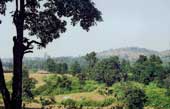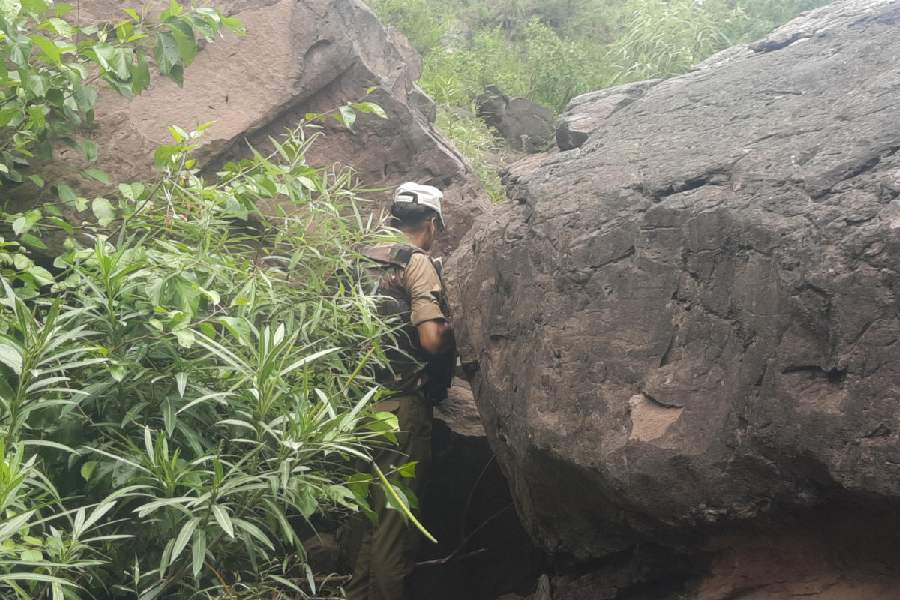 |
 |
To the west of the state lies the district of Purulia, characterised by forests, hills and tribes. The climate remains dry round the year. Together with the crimson soil, this gives the land its unique rugged quality.
The most important tourist attraction in this region is the sprawling Ayodhya Hills, a part of the Chhotanagpur plateau. The average altitude here is approximately 200 m above sea level. The highest peak is Gangaburu at 2,220 ft (676 m).
The region has long been a draw for rock-climbers and trekkers. Bagmundi, surrounded by rocky cliffs, to the west of Ayodhya Hills, also attracts climbers.
The trail from Sirkabad to Ayodhya is perfect for jungle trekking. The 13-km journey through a dense jungle of mostly Shimul and Palash takes five-six hours. When in bloom, the plants turn the region red.
The outstanding feature of Ayodhya Hills is the hospitality the tribals extend to every single person who visits their villages. It is a treat for people from the city to mingle with people who are so simple, innocent and friendly. The tribal men and women have retained their distinctiveness in the face of abject poverty and social oppression.
There is a regular bus service from Purulia town to the top of Ayodhya Hills several times a day. Finding a place to stay here will not be a problem since there are plenty of accommodation options to suit different budgets. Most of the lodges and hotels are near the main bus stand, which also houses a small market.
The fare at roadside eateries will satisfy those with simple tastes. If you do not mind walking miles then nothing can beat a day outdoors. Wander among the Mohua trees in the soft breeze, occasionally stopping at picturesque clusters of two-storeyed mud huts. If you can befriend the villagers, they will certainly invite you for a cup of tea.
A leisurely walk will take you to Mayur Pahar (Peacock Hills). The peak offers a panoramic vista of the lush green Ayodhya range. The sunset here is memorable.
Venture out early in the morning to Bamni Falls. About two hours of brisk walk will take you there. You can return in time for lunch.
The most important festival of the tribals of Ayodhya is Shikar. This daylong event is celebrated on Baisakhi Purnima, in the month of April/May. Men take part in the hunt for rabbits and hedgehogs. However, one has to brave the extreme heat to experience this stunningly colourful festival.
Going
There?s a regular bus service from Purulia town to the top of Ayodhya Hills. The 30-km journey takes close to two hours. Trains are available from Howrah to Purulia.
To visit Joychandi Hills, take the overnight Adra-Chakradharpur Express from Howrah. Raghunathpur is 15 minutes from Adra
Staying
There are several lodges and hotels at Ayodhya Hills. There?s something for every budget. There are a few lodges at Raghunathpur. Joychandi Hills is just a walk away from Raghunathpur
Joychandi Hills
 |
One of nature?s wonders awaits you at Joychandi Hills, a stone?s throw from Ayodhya Hills. Staggering rock formations shoot up from nowhere to take your breath away. This part of Purulia is not as well known as Ayodhya Hills, but is just as beautiful.
Only local trains pass through the nearest railway station, also called Joychandi. The best way to reach the hills is to get down at Adra. The trains from Howrah reach early in the morning. Buses and autorickshaw are available from Adra to Raghunathpur. The journey takes around 15 minutes.
On the border of Raghunathpur is Nanduara, a village virtually at the foothills. The winding road through the hamlet leads to a wide open space bordered by the three major hills of the area ? Joychandi, Dakshinakali or Kalipahar, and Jugadhal (dhal means slope).
To reach the top, one must be adept at rock-climbing. In fact, many people come here to hone their rock-climbing skills. However, a concrete staircase has been built on the slope of Joychandi Hills for pilgrims headed for the Chandimata temple. A stone idol was once worshipped in the dilapidated structure. It has recently been replaced with a deity brought from Varanasi.
The top of the hills offers a wonderful view of the plains of Purulia, including the Santhal villages. Huge boulders hover over most of the houses. The residents of Nanduara spend their days in constant fear of a rockslide.
Of the three hills, Jugadhal is the tallest. During the British era, a court used to be convened at the top of the hill. Those sentenced to death were pushed down the slope!
In February, a week-long mela is held at the foot of Joychandi Hills. People from different parts of the districts congregate here to offer puja to goddess Chandimata.
Satyajit Ray shot certain portions of Hirak Rajar Deshe, the sequel to Goopy Gyne Bagha Byne, around Joychandi Hills in 1978. He was looking for a typical Bengali village surrounded by hills. In Nanduara, you are likely to come across many villagers who still remember the day they ran away from school to watch the great director in action.










